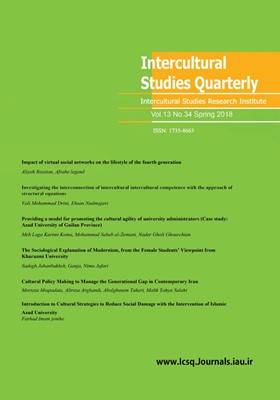The Sociological Explanation of Fashionism, From the Female Students’ Viewpoint in Kharazmi University
Subject Areas : INTERCULTURAL STUDIES QUARTERLYsadegh jahanbakhshganjeh 1 , nima jafari 2
1 - .....
2 - ......
Keywords: Economic and Social Base, Body Management, Fashionism, leisure,
Abstract :
Fashionism is one of the most important social issues in the modern world. It is a kind of consumption, which is not for the satisfaction of the biological needs; however, it is for the social purposes. Accordingly, this study aims to highlight the significant role of the fashionism, which intends to introduce the sociological explanation of fashionism from the female students’ viewpoints in Kharazmi University. Due to the vast realities of fashionism in people’s lives, the compilation theoretical framework was chosen based on the theories of Simmel, Veblen, and Bourdieu for a general guide to the research. The research method is the descriptive correlation. The statistical population of the study consisted of all girls who studied in Kharazmi University in 2016-2017. Three hundred and sixty two of them, as the case study, were chosen by using the simple random sampling method. To collect the research data, we used a researcher-made questionnaire. The data were analyzed by using Pearson correlation coefficient, independent T-test, analysis of variance, and regression. The results of the study showed that there is a positive and significant relationship between the variables of body management, leisure time, economic and social bases with a fashionism orientation. Moreover, the multiple regression analysis showed that the leisure time and the body management of 32% totality of the variance of the dependent variables could explain the tendency to the fashionism
آدمیان، مرضیه، عظیمی هاشمی، مژگان و صنعتی شرقی، نادر (1391) «تحلیل جامعهشناختی سبک پوشش زنان»، فصلنامه علمی پژوهشی زن و جامعه، سال سوم، شماره 4، 186-161.
اسفندیار، سرور (1387)، واقعیت مد و مدگرایی، ماهنامه پیام زن، شماره 196، 25-22.
افراسیابی، حسین، سیارخلج، حسین و شکوهی فر، کاوه (1395)، «عوامل مرتبط با مدگرایی در بین جوانان شهر یزد»، فصلنامه جامعه پژوهی فرهنگی، سال هفتم، شماره 1، 64-35.
بزرگیان، امین (1388)، ایدههای خیابانی: نوشتههایی دربارة شهر، تن و زندگی روزمره، تهران: انتشارات ققنوس.
بخارایی، احمد و رفیعی، ملکه (1395)، «زنان و گرایش به مد»، زن در توسعه و سیاست، دوره چهاردهم، شماره 3، 328-309.
پورسفی، حمید، طایفه، اشرف و آقاپورفرگوش، مجید (1388)، «بررسی جامعهشناختی عوامل مؤثر بر الگوپذیری رفتار اجتماعی دختران»، پژوهشنامه علوم اجتماعی، سال سوم، شماره 1، 192-159.
پیلتن، فخرالسادات و طالبی، حسین (1392)، «بررسی عوامل اجتماعی گرایش به مد در بین نوجوانان (موردمطالعه دانش آموزان دختر دبیرستانهای شهر میناب)»، فصلنامه مطالعات جامعهشناختی جوانان، سال چهارم، شماره 11، 64-49.
حاتمی، خدیجه، کواسمی، ایوب و آقایاری هیر، توکل (1394)، بررسی رابطه بین همرنگی، تشخص طلبی و طبقه اجتماعی اقتصادی با میزان مدگرایی مورد مطالعه: دانشجویان کارشناسی دانشگاه تبریز، جامعه شناسی کاربردی، سال بیست و ششم، شماره پیاپی60، 212-199.
حمیدی، نفیسه و فرجی، مهدی (1387)، «سبک زندگی و پوشش زنان در تهران»، فصلنامه تحقیقات فرهنگی، سال اول، شماره 1، 92-65.
خانی، هادی (1386)، بررسی تأثیر پایگاه اقتصادی ـ اجتماعی و میزان دینداری بر سبک زندگی دانشجویان دانشگاه تربیتمعلم تهرانـ حصارک، پایاننامه کارشناسی ارشد، دانشگاه خوارزمی.
رفعت جاه، مریم (1390)، «فراغت و ارزشهای فرهنگی»، فصلنامه تحقیقات فرهنگی، دورة چهارم، شماره 1، 190-151.
زارع شاه آبادی، اکبر و طاهر، مریم (1395)، مطالعه بین نسلی سبک زندگی دختران و مادران شهر یزد، مطالعات اجتماعی روانشناختی زنان، سال چهاردهم، شماره 4، 36-7.
سازمان ملی جوانان دفتر مطالعات و تحقیقات اجتماعی (1384)، اوقات فراغت و سبک زندگی جوانان.
شیخ سفلی، لیلا (1391)، «جوانان و مدگرایی». ماهنامه سرباز، شماره 190، 39-38.
فرخ نیا، رحیم و لطفی، اعظم (1390)، «بررسی تأثیر فضای مجازی اینترنت بر مدگرایی»، فصلنامه مطالعات فرهنگی و ارتباطات، شماره 22، 115-92.
فرهنگی، علیاکبر و کیانا، هانیه (1391)، تأثیر رسانهها در تبلیغ سبک زندگی غربی با تأکید بر الگوی پوشش غربی، دو فصلنامه علمی پژوهشی پاسداری فرهنگی انقلاب اسلامی دانشکده علوم انسانی و قدرت نرم دانشگاه افسری و تربیت پاسداری امام حسین(ع)، سال دوم، شماره 5، 163-139.
قادری، طاهره و رضایی، سپیده (1393)، رابطه سرمایه فرهنگی و گرایش جوانان به مد (تفاوت بین دختران و پسران)، فصلنامه علوم اجتماعی، شماره 66، 34-1.
قربانی، سمیه (1387)، لذت و تکرار (مد و زندگی روزمره از دیدگاه جرج زیمل)، مجله ادبیات و زبانها، خردنامه همشهری، شماره 28، 63-62.
کرایب، یان (1391)، نظریههای اجتماعی کلاسیک مقدمهای بر اندیشه مارکس، وبر، دورکهیم، زیمل، ترجمه شهناز مسمی پرست، تهران: نشر آگه، چاپ پنجم.
کردی، حسین و هادی زاده، سکینه (1391)، بررسی سبک زندگی زنان شاغل و غیر شاغل، فصلنامه علمی پژوهشی زن و جامعه، سال سوم، شماره 4، 41-21.
میرآخوندی، مهدی (1388)، مد و مدگرایی و تأثیرات آن در تغییرات فرهنگی جوامع، ماهنامه صنعت نساجی و پوشاک، شماره316، 37-33.
میرجلیلی، آزاده، (1392) «مبانی طراحی مد»، مجله چیدمان، سال دوم، شماره 2، 29-26.
Alexandra, C, Y. Leung , Rachel W, Y. Yee , Eric S, C (2015), Psychological and Social Factors of Fashion Consciousness: An Empirical Study in the Luxury Fashion Market, Research Journal of Textile and Apparel, Vol. 19 Iss: 3, pp.58 – 69.
Baker - pitts, C (2008), Symptom of Solution: The RelationalMeaning on Cosmetic Surgery for Women. PhD Thesis. New YorkUniversity.
Fardouly, J, Diedrichs, P, C. Vartanian, R, Halliwell, E (2015), The Mediating Role of Appearance Comparisons in the Relationship Between Media Usage and Self-Objectification in Young Women, Psychology of Women Quarterly, Vol 39, 447-457.
Robinson, B (2003), Method of clothing and influence of body and appearance management. Department of Psychology, University of Gothenburg.
Tee, P, K, Gharleghi, B, Chan, B, Samadi, B, Balahmar, A, A, (2015), Purchase Intention of International Branded Clothes Fashion among Younger’s in Jakarta, International Journal of Business and Social Research: vol 5, No, 8, 8-17.
Tiggemann, M, Lacey, M (2009), Catherine Shopping for clothes: Body satisfaction, appearance investment, and functions of clothing amonge female shoppers.


